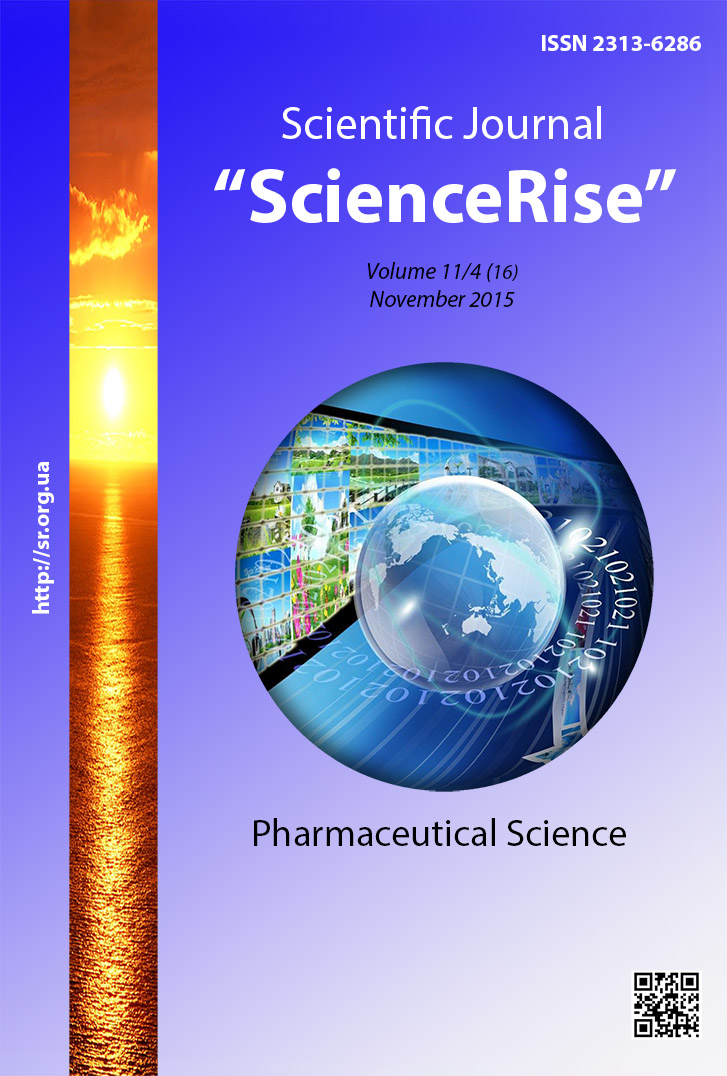Синтез ансамблів сукцинильованих похідних інтерлейкіну-2 та їх біологічна активність in vitro
DOI:
https://doi.org/10.15587/2313-8416.2015.53985Ключові слова:
Agilent-2100, біологічна активність, сукцинильований інтерлейкін-2, високоефективної рідинної хроматографії, рекомбінантний інтерлейкін-2Анотація
Мета: дослідити біологічну активність комбінаторних сукцинильованих похідних інтерлейкіну-2 (IL-2). Ацилювання з різними ступенями ацилювання IL-2 проводили з використанням бурштинового ангідриду, з утворенням складного ансамблю із багатьох похідних (квазі-жива структура, здатна до самоорганізації).
Методи: У дослідженні використовували рекомбінантний інтерлейкін-2 (IL-2) (Ronkoleukin, Росія) в окисненій формі та інші реагенти Sigma-Aldrich і Fluka (США). Для ацилювання використовували рекомбінантний IL-2 у вигляді матричної рідини з концентрацією білка 0,6 мг/мл. Матричний розчин IL-2 був доведений до рН 8,0 шляхом додавання 0,01 % розчину гідроксиду натрію. Синтезований ансамбль сукцініл-IL-2 аналізували за допомогою капілярного гель-електрофорезу на приладі Agilent- 2100 Bioanalyzer. Молекулярні маси синтезованого ансамблю аналізували у порівнянні зі стандартними зразками низькомолекулярних білків Bioanalyzer (Ladder). Додатковий негативний заряд модифікованого IL-2 визначали за допомогою FPLC (швидкої рідинної хроматографії протеїнів) системи від Pharmacia (Woerden, Нідерланди). CTLL-2, мишача ІЛ-2-залежна клітинна лінія, була отримана з Biokontrol (Київ, Україна). Ці клітини були використані в аналізі рівню проліферації (реакція бластної странсформації або БТЛ) в порівнянні активності IL-2 і сукцинильованих похідних IL-2. Для статистичного аналізу даних був використаний дисперсійний аналіз.
Результати: клітинна лінія CTLL-2 була оброблена різними концентраціями похідних Suc-IL-2. Найвищий рівень біологічної активності мав Suc-IL-2 з чотирма модифікованих залишків лізину. Таким чином, сукцинильоване похідне IL-2 з чотирма заміщеними залишками лізину може бути використане в розробці майбутніх імунотропних протиракових засобів.
Висновки: Десятикратне збільшення біологічної активності IL-2 спостерігалося після часткового сукцинилювання його структури. Це явище можна використовувати в розробці нових біотехнологічних препаратів на основі похідних IL-2 для зменшення концентрації основної активної речовини в лікарській формі при тій же біологічній активності та для розширення спектру активности інтерлейкіну-2
Посилання
Adibzadeh, M., Weder, H. G., Rehbein, A., Schwuléra, U., Obermeier, J., Pawelec, G. (1992). Activity of liposomal interleukin-2 in vitro. Mol. Biother. 4 (1), 24–28.
Okuno, K., Nakamura, K., Tanaka, A., Yachi, K., Yasutomi, M. (1998). Hepatic immunopotentiation by galactose-entrapped liposomal IL-2 compound in the treatment of liver metastases. Surg Today, 28 (1), 64–69. doi: 10.1007/bf02483610
Apisarnthanarax, N., Talpur, R., Duvic, M. (2002). Treatment of Cutaneous T Cell Lymphoma. American Journal of Clinical Dermatology, 3 (3), 193–215. doi: 10.2165/00128071-200203030-00006
Martynov, A. V., Smelyanskaya, M. V. (2005). Antiproliferative Properties of Chemically Modified Recombinant IFN-α2b. Journal of Interferon & Cytokine Research, 25 (7), 414–417. doi: 10.1089/jir.2005.25.414
Koppenhagen, F. J., Storm, G., Underberg, W. J. M. (1998). Development of a routine analysis method for liposome encapsulated recombinant interleukin-2. Journal of Chromatography B: Biomedical Sciences and Applications, 716 (1-2), 285–291. doi: 10.1016/s0378-4347(98)00271-0
Hank, J. A., Surfus, J., Gan, J., Albertini, M., Lindstrom, M., Schiller, J. H., Hotton, K. M., Khorsand, M., Sondel, P. M. (1999). Distinct Clinical and Laboratory Activity of Two Recombinant Interleukin-2 Preparations. Clin. Cancer Res., 5 (2), 281–292.
Arkin, M. R., Randal, M., DeLano, W. L., Hyde, J., Luong, T. N., Oslob, J. D. et. al (2003). Binding of small molecules to an adaptive protein-protein interface. Proceedings of the National Academy of Sciences, 100 (4), 1603–1608. doi: 10.1073/pnas.252756299
Rosenberg, S. A. (1988). New Approaches to the Immunotherapy of Cancer Using Interleukin-2. Annals of Internal Medicine, 108 (6), 853. doi: 10.7326/0003-4819-108-6-853
Kohler, P. C., Hank, J. A., Moore, K. H., Storer, B., Bechhofer, R., Sondel, P. M. (1987). Phase I clinical evaluation of recombinant interleukin-2. Prog. Clin. Biol. Res., 244, 161–172.
Lotze, M. T., Matory, Y. L., Rayner, A. A., Ettinghausen, S. E., Vetto, J. T., Seipp, C. A., Rosenberg, S. A. (1986). Clinical effects and toxicity of interleukin-2 in patients with cancer. Cancer, 58 (12), 2764–2772. doi: 10.1002/1097-0142(19861215)58:12<2764::aid-cncr2820581235>3.0.co;2-z
Gearing, A. J. H., Thorpe, R. (1988). The international standard for human interleukin-2. Journal of Immunological Methods, 114 (1-2), 3–9. doi: 10.1016/0022-1759(88)90145-7
Salunkhe, S., Soorapaneni, S., Prasad, K. S., Raiker, V. A., Padmanabhan, S. (2010). Strategies to maximize expression of rightly processed human interferon α2b in Pichia pastoris. Protein Expression and Purification, 71 (2), 139–146. doi: 10.1016/j.pep.2010.02.007
Cohen, J. (1992). A power primer. Psychological Bulletin, 11 2(1), 155–159. doi: 10.1037/0033-2909.112.1.155
Arkin, M. R., Randal, M., DeLano, W. L., Hyde, J., Luong, T. N., Oslob, J. D. et. al (2003). Binding of small molecules to an adaptive protein-protein interface. Proceedings of the National Academy of Sciences, 100 (4), 1603–1608. doi: 10.1073/pnas.252756299
##submission.downloads##
Опубліковано
Номер
Розділ
Ліцензія
Авторське право (c) 2015 Artur Martynov, Boris Farber, Sophia Farber, Tatiana Kabluchko

Ця робота ліцензується відповідно до Creative Commons Attribution 4.0 International License.
Наше видання використовує положення про авторські права Creative Commons CC BY для журналів відкритого доступу.
Автори, які публікуються у цьому журналі, погоджуються з наступними умовами:
1. Автори залишають за собою право на авторство своєї роботи та передають журналу право першої публікації цієї роботи на умовах ліцензії Creative Commons CC BY, котра дозволяє іншим особам вільно розповсюджувати опубліковану роботу з обов'язковим посиланням на авторів оригінальної роботи та першу публікацію роботи у цьому журналі.
2. Автори мають право укладати самостійні додаткові угоди щодо неексклюзивного розповсюдження роботи у тому вигляді, в якому вона була опублікована цим журналом (наприклад, розміщувати роботу в електронному сховищі установи або публікувати у складі монографії), за умови збереження посилання на першу публікацію роботи у цьому журналі.

